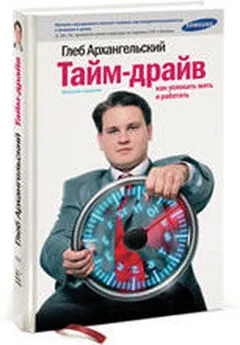Ричард convertfileonline.com - _2016_02_09_21_40_03_404
- Название:_2016_02_09_21_40_03_404
- Автор:
- Жанр:
- Издательство:Манн, Иванов и Фербер
- Год:2016
- ISBN:9785000577332
- Рейтинг:
- Избранное:Добавить в избранное
-
Отзывы:
-
Ваша оценка:
Ричард convertfileonline.com - _2016_02_09_21_40_03_404 краткое содержание
_2016_02_09_21_40_03_404 - читать онлайн бесплатно полную версию (весь текст целиком)
Интервал:
Закладка:
[2]John Robinson and Geoffrey Godbey, Time for Life: The Surprising Ways Americans Use Their Time, 2nd ed. University Park: Pennsylvania State University Press, 1997.
[3]John Robinson and Geoffrey Godbey, Time for Life: The Surprising Ways Americans Use Their Time. Глава 16, “Perceptions of Time Pressure,” pp. 229–240.
[4]John Robinson and Geoffrey Godbey, Time for Life: The Surprising Ways Americans Use Their Time, с. xvi.
[5]July 20, 2011, “In US, 3 in 10 Working Adults Are Strapped for Time,” at http://www.gallup.com/poll/148583/Working-Adults-Strapped-Time.aspx?utm_source=alert&utm_medium=email&utm_campaign=syndication&utm_content=morelink&utm_term=Wellbeing.
[6]Paul Romer, “Time: It Really Is Money,” Information Week, September 11, 2001. Классическое исследование о проблемах распределения времени представлено в работе GaryBecker, “ATheoryoftheAllocationofTime,”EconomicJournal (75) (1965): 493–517. См. также: Stephan Linder, The Harried Leisure Class. New York: Columbia University Press, 1970.
[7]US Census Bureau, “Median Age at First Marriage, 1890–2010,” at www.infoplease.com/ipa/A0005061.html.
[8]“Barely Half of US Adults Are Married—a Record Trend,” Pew Research Center, Social and Demographic Trends, December 12, 2011, http://www.pewsocialtrends.org/2011/12/14/barely-half-of-u-s-adults-are-married-a-record-low/.
[9]Robinson and Godbey, Time for Life, p. 44.
Глава 8
[1]Janelle Brown, “A Poster Child for Internet Idiocy,” Salon.com, August 1, 2001, at http://www.salon.com/2000/08/01/dotcomguy/.
[2]Joseph Pine III and James H. Gilmore, The Experience Economy: Work Is Theatre and Every Business a Stage. Boston: Harvard Business School Press, 1999, pp. 2, 11 (издана на русском языке: Пайн II Б., Гилмор Дж. Экономика впечатлений. Работа — это театр, а каждый бизнес — сцена. М. : Вильямс, 2005).
[3]Carl Rogers, “Toward a Theory of Creativity,” in On Becoming a Person: A Therapist’s View of Psychotherapy. Boston: HoughtonMifflin, 1961, pp. 352–354 (издана на русском языке: Роджерс К. Становление личности. Взгляд на психотерапию. М. : Эксмо-Пресс, 2001).
[4]Andy Sheehan, Chasing the Hawk. New York: Delacorte, 2001.
[5]Cited in Joan Raymond, “Happy Trails: America’s Affinity for the Great Outdoors,”American Demographics (August 2000): 1–4.
[6]US Bureau of Economic Analysis, National Income and Product Accounts, http://www.bea.gov/iTable/iTable.cfm?ReqID=9&step=1#reqid=9&step=3&isuri=1&903=63.
[7]Bear Stearns, America at Leisure, p. 33; 2009 данные из пресс-релиза IHRSA.
[8]Kris Hudson, “Gyms Working Out for Landlords,” Wall Street Journal, September 7, 2011.
[9]John Robinson and Geoffrey Godbey, Time for Life: The Surprising Ways Americans Use Time, 2nd ed. University Park: Pennsylvania State University Press, 1999.
[10]Бюро кредитных историй Equifax составляет справочник Lifestyle Market Analyst на основании 15,3 миллиона анкет, информация из которых взвешивается и классифицируется в соответствии с демографическими данными Бюро переписи населения США и компании Claritas. Рейтинг видов деятельности по различным демографическим группам и категориям дохода, а также по географическим регионам, составляется на основании индекса образа жизни. Значение 100 для этого индекса считается средним по стране, следовательно, при значении индекса больше 100 он превышает средний показатель по стране, а если меньше 100, то он ниже среднего показателя по стране.
[11]Bureau of Labor Statistics, Spotlight on Statistics: Sports and Exercise, May 2008, www.bls.gov/spotlight/2008/sports/.
[12]Личные интервью автора, зима 2000 года.
[13]Личные интервью автора, весна 2000 года.
[14]Paul Fussell, Class: A Guide Through the American Status System. New York: Summit, 1983, p. 115.
[15]“The American Fitness Index, 2011”, www.americanfitnessindex.org/docs/reports/2011_afi_report_final.pdf
[16]Mark Banks, “Fit and Working Again? The Instrumental Leisure of the Creative Class,” Journal of Environment and Planning (2009), p. 668–681. См. также: Richard Lloyd, Neo-Bohemia: Art and Commerce in the Postindustrial City. New York: Routledge, 2006.
[17]Shirley S. Wang, “Coffee Break? Walk in the Park? Why Unwinding Is Hard,” Wall Street Journal, August 31, 2011.
[18]David Byrne, Bicycle Diaries (New York: Viking, 2009), p. 2 (издана на русском языке: Бирн Д. Записки велосипедиста. СПб : Амфора, 2013).
[19]Существует много книг по этой теме, например: Nicholas Fyfe, ed., Images of the Street: Planning, Identity and Control in Public Space. New York: Routledge, 1998; Tracy Skelton and Gil Valentine, eds., Cool Spaces: Geographies of Youth Cultures. New York: Routledge, 1998. См. также: Janine Lopiano-Misdom and Joanne De Luca, Street Trends: How Today’s Alternative Youth Cultures Are Creating Tomorrow’s Mainstream Markets. New York: HarperBusiness, 1997)
[20]Ben Malbon, Clubbing: Dancing, Ecstasy, Vitality (Critical Geographies). New York: Routledge, 1999, p. 174.
[21]Joseph Yi and Daniel Silver, “God, Yoga and Kareate: Local Amenities and Pathways to Diversity; of Toronto, Rotman School of Management, Martin Prosperity Institute Working Paper Series, 2011. В интернете: http://research.martinprosperity.org/2012/01/god-yoga-and-karate/.
[22]См. Thomas Frank, One Market Under God: Extreme Capitalism, Market Populism, and the End of Economic Development. New York: Doubleday, 2001; The Conquest of Cool: Business Culture, Counterculture, and the Rise of Hip Consumerism. Chicago: University of Chicago Press, 1997.
[23]Malbon, Clubbing, p. 55.
[24]Kara Swisher, “How Kitchen Fixes Can Add Up Fast,” Wall Street Journal, August 7, 2001.
Глава 9
[1]Max Weber, The Protestant Ethic and the Spirit of Capitalism. London: Routledge, 1992 [orig. 1921] (издана на русском языке: Вебер М. Протестантская этика и дух капитализма. М. : Центр гуманитарных инициатив, 2013).
[2]См., например: «Всякая душа да будет покорна высшим властям, ибо нет власти не от Бога; существующие же власти от Бога установлены» (К римлянам, 13:1). «Рабов [увещевай] повиноваться своим господам, угождать им во всем, не прекословить» (К Титу, 2:9). «Напоминай им повиноваться и покоряться начальству и властям, быть готовыми на всякое доброе дело» (К Титу, 3:1).
[3]Cesar Grana, Bohemian Versus Bourgeois. New York: Basic Books, 1964. Впоследствии было опубликовано расширенное издание книги: Modernity and Its Discontents: French Society and the French Man of Letters in the Nineteenth Century. New York: Harper Torchbooks, 1967.
[4]Georg Lukas, History and Class Consciousness, trans. Rodney Livingstone Cambridge: MIT Press, 1971; Antonio Gramsci, Prison Notebooks: Selections, ed. and trans. Quintin Hoare. New York: Geoffrey N. Smith International Publishers Company, 1971.
[5]Grana, Modernity and Its Discontents, p. 169.
[6]Grana, of course, has Paris covered. On Greenwich Village, см. классическое исследование: Carolyn Ware, Greenwich Village, 1920–1930. Berkeley: University of California Press, 1963 [orig. 1935].
[7]Grana, Modernity and Its Discontents, p. 208.
[8]Daniel Bell, The Coming of Post-Industrial Society. New York: Basic Books, 1973.
[9]Daniel Bell, The Coming of Post-Industrial Society. New York: Basic Books, 1973, с. 13.
[10]Классической работой о нарциссизме в нашем обществе по-прежнему остается книга: Christopher Lasch, The Culture of Narcissism: American Life in an Age of Diminishing Expectations. New York: W. W. Norton, 1979.
[11]Bell, The Cultural Contradictions of Capitalism. New York: Basic Books, 1976, pp. xxiv–xxv. Курсив в оригинале.
[12]Bell, The Cultural Contradictions of Capitalism. New York: Basic Books, 1976, с. 21–22.
[13]David Brooks, Bobos in Paradise: The New Upper Class and How They Got There. New York: Simon and Schuster, 2001.
[14]David Brooks, Bobos in Paradise: The New Upper Class and How They Got There. New York: Simon and Schuster, 2001.
[15]David Brooks, “The Organization Kid,” Atlantic 287 (4) (April 2001): 40–54.
[16]David Brooks, “The Organization Kid,” Atlantic 287 (4) (April 2001): 40–54, с. 54.
[17]Комплексный консервативный анализ 1960-х годов можно найти здесь: Roger Kimball, The Long March: How the Culture Revolution Changed America. San Francisco: Encounter Books, 2000.
[18]Существует огромное количество книг о субкультурах; см., например: Dick Hebidge, Subculture: TheMeaningofStyle. London: Methuen, 1979; Ken Gelder and Sarah Thornton, eds., The Subcultures Reader. London: Routledge, 1997.
[19]Tom Frank, One Market Under God: Extreme Capitalism, Market Populism, and the End of Economic Development. New York: Doubleday, 2001; The Conquest of Cool: Business Culture, Counterculture, and the Rise of Hip Consumerism. Chicago: University of Chicago Press, 1997. См. также: Kalle Lasn, Culture Jam: The Uncooling of America. New York: Eagle Brook/William and Morrow, 1999.
[20]См. Greil Marcus, Mystery Train: Images of America in Rock’n’Roll Music. New York: Penguin, 1975; Lipstick Traces; A Secret History of the Twentieth Century. Cambridge: Harvard University Press, 1989; Double Trouble: Bill Clinton and Elvis Presley in a Land of No Alternatives. New York: Henry Holt, 2000.
Читать дальшеИнтервал:
Закладка:






